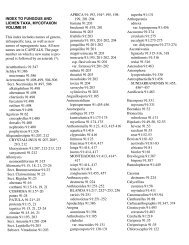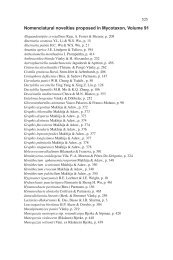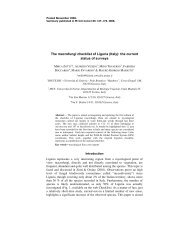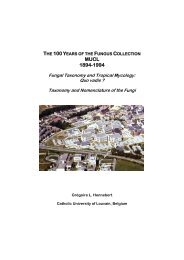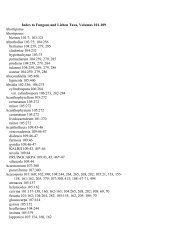download full review [pdf] - Mycotaxon
download full review [pdf] - Mycotaxon
download full review [pdf] - Mycotaxon
You also want an ePaper? Increase the reach of your titles
YUMPU automatically turns print PDFs into web optimized ePapers that Google loves.
528 ... Hawksworth, Editor<br />
determinations, and the comparatively high price will not endear it to potential<br />
purchasers.<br />
Peter Roberts<br />
Lower Penylan, Glasbury, Powys HR3 5NT, UK<br />
Ascomycetes<br />
Taxonomy, phylogeny, and ecology of bark-inhabiting tree-pathogenic fungi<br />
in the Cryphonectriaceae. By Marieka Gryzenhout, Brenda D. Wingfield &<br />
Michael J. Wingfield. 2009. APS Press, American Phytopathological Society, 340 Pilot<br />
Knob Road, Saint Paul, MN 55121, USA . Pp. x + 119, col. figs 14,<br />
other figs 38. ISBN 978-0-89054-367-2. Price US $ 119.<br />
This family includes some of the most devastating fungal pathogens of trees,<br />
most famously the causal agent of Chestnut blight (Cryphonectria parasitica)<br />
that spectacularly almost destroyed the American chestnut (Castanea dentata)<br />
in North America while seriously damaging the European chestnut (C. sativa)<br />
in the early 1900s. From around 1980, Cryphonectria cubensis and some allied<br />
species have been causing serious problems on Eucalyptus trees. Yet the family<br />
has only recently started to be examined critically, and this has led to the<br />
recognition of no less than nine new genera and many new species related to<br />
Cryphonectria and Endothia in the last few years as a result of careful molecular<br />
and morphological studies – especially involving the first author, and some of<br />
the results are published here for the first time. However, no synthesis of all the<br />
new information now available has previously been made.<br />
The first 39 pages of this book focus on the diseases these fungi cause, their<br />
distributions, control, and molecular systematics. Following these sections,<br />
there are dichotomous and synoptic keys to the genera – and then the heart of<br />
the work, formal taxonomic treatments with <strong>full</strong> nomenclatural information,<br />
detailed descriptions (including ones of cultures), data on hosts and distribution,<br />
details of specimens examined, excellent line drawings and photomicrographs,<br />
and often extensive “Notes”. Twenty-two species are accepted, and these are<br />
now referred to eleven different genera. A further four species are excluded as<br />
belonging elsewhere, and several others of “questionable” status (not “validity”<br />
as used in the section headings, as all the names seem to be validly published)<br />
are discussed.<br />
Such studies may at first be assumed to be remote and somewhat irrelevant<br />
by many hands-on plant pathologists, but in reality they are the essential<br />
underpinning of all critical work in plant and forest pathology. I was very<br />
pleased to see APS Press demonstrate, by publishing this work, that they<br />
recognize the value of authoritative and critical taxonomic revisions of fungal<br />
groups including plant pathogens. It is to be hoped that APS will be encouraged


![download full review [pdf] - Mycotaxon](https://img.yumpu.com/5381692/20/500x640/download-full-review-pdf-mycotaxon.jpg)
